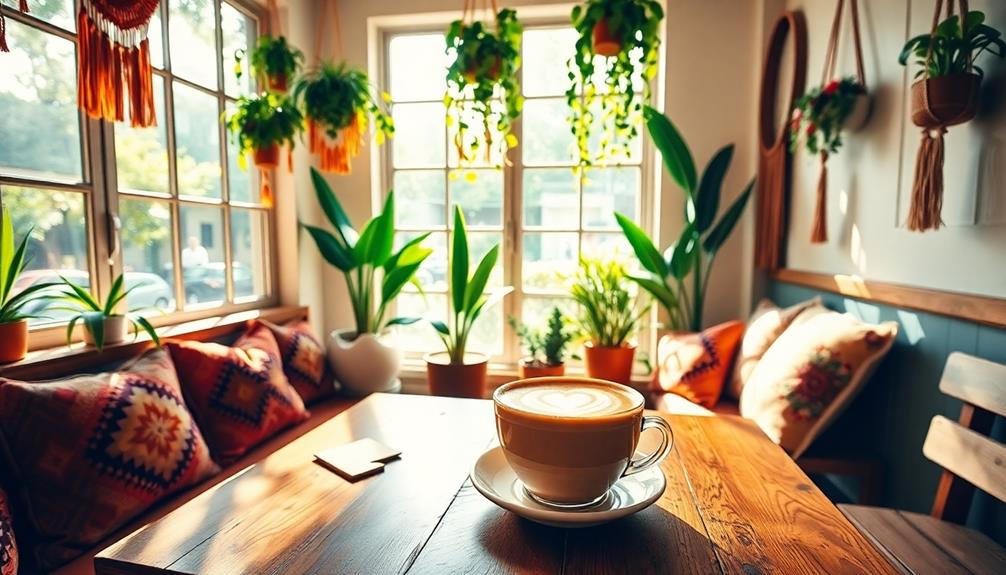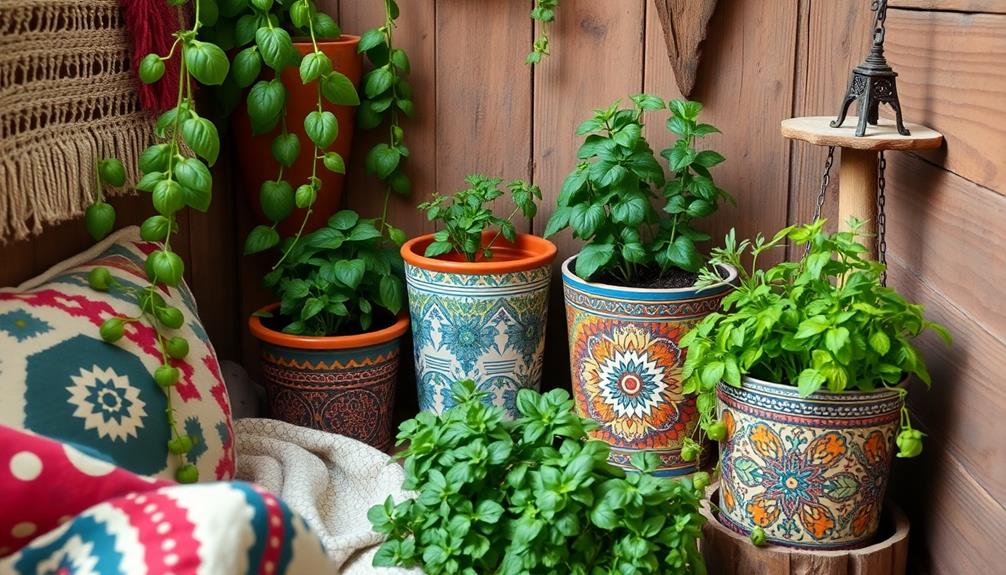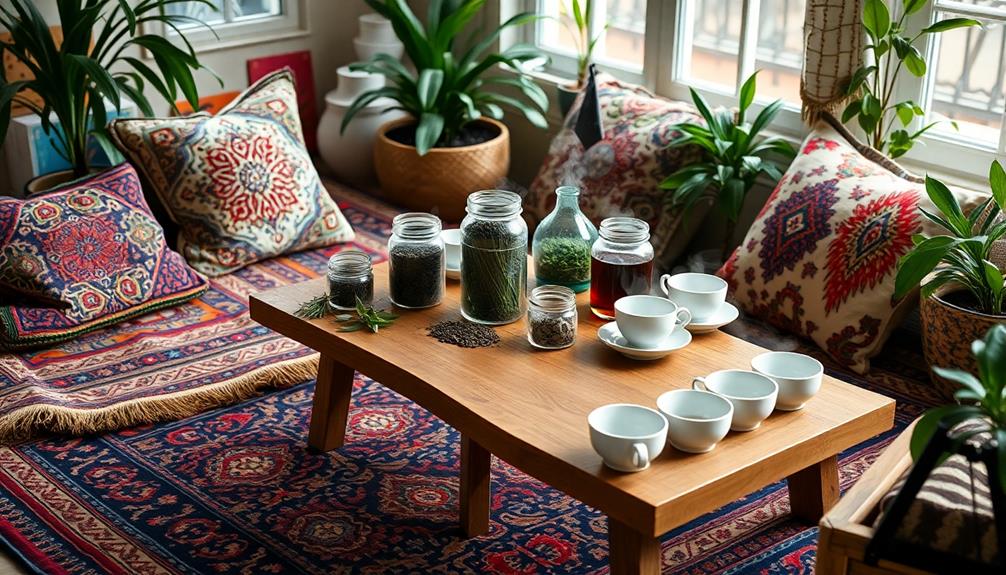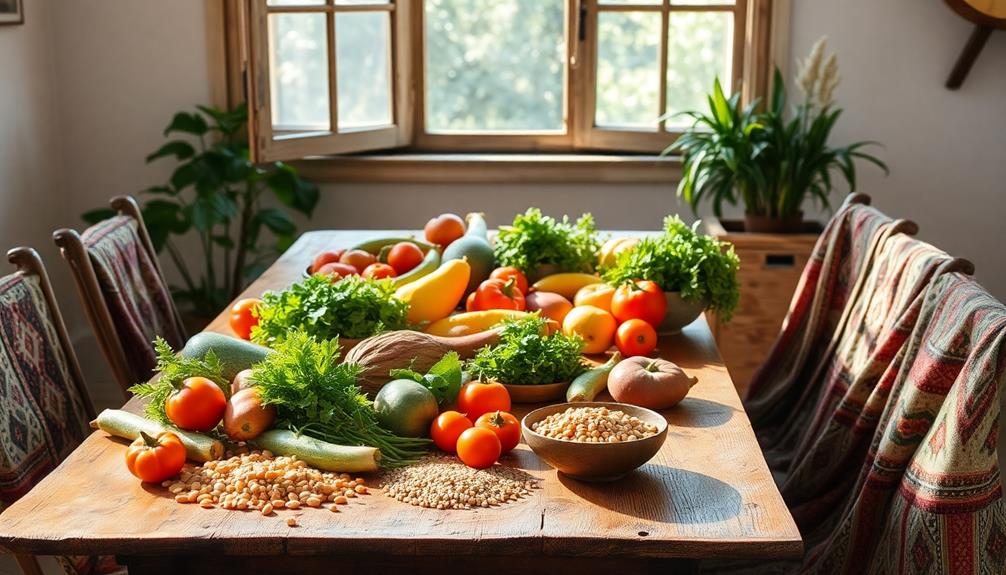If you are looking for the top boho cafes from all over the world, you are in for a real treat. From the charming Kafe Utu in Singapore with its striking artwork to the Dalloway Terrace in London filled with picturesque floral displays, you will find a variety of unique and cozy spots to enjoy. Whether it’s the rustic baked goods at Fox in the Snow in Columbus or the historic bohemian vibe at Café de Flore in Paris, each cafe offers a welcoming atmosphere and innovative menu. These cafes showcase beautiful decor and celebrate creativity and community. There is so much more to discover about these delightful venues.
Key Takeaways
- Kafe Utu in Singapore offers vibrant artwork and eclectic decor, creating a lively boho atmosphere.
- Dalloway Terrace in London captivates with its beautiful floral displays and charming outdoor seating, perfect for relaxation.
- Fox in the Snow in Columbus, Ohio features rustic baked goods and a cozy setting, ideal for casual gatherings.
- Café de Flore in Paris exudes a classic bohemian vibe with historic charm and a popular outdoor terrace.
- Each of these cafes highlights local culture and community engagement through unique decor and menus.
Captivating Decor and Aesthetics
When you step into a boho cafe, the enchanting decor instantly draws you in with its eclectic charm. The inviting atmosphere wraps around you like a warm blanket, making you feel right at home.
You'll notice the blend of vintage and natural elements, creating a cozy environment that encourages you to linger. Earthy tones and soft textures fill the space, enhancing the overall ambiance and evoking a sense of comfort. Incorporating transformative decor ideas can further elevate the cafe's tranquility, inviting guests to unwind completely.
As you explore, you'll find greenery adorning every corner, connecting you with nature and providing a revitalizing vibe. The plants breathe life into the decor, making each visit feel like an escape.
Look around, and you'll see artistic wall murals and local artwork serving as focal points, adding personality and charm to the cafe.
The furniture is just as engaging, showcasing a mix of styles with mismatched chairs and tables that promote a relaxed environment for social interaction.
Whether you're catching up with friends or enjoying a quiet moment alone, the eclectic decor of boho cafes creates a backdrop that inspires creativity and connection, inviting you to embrace the moment fully.
Community-Centric Spaces
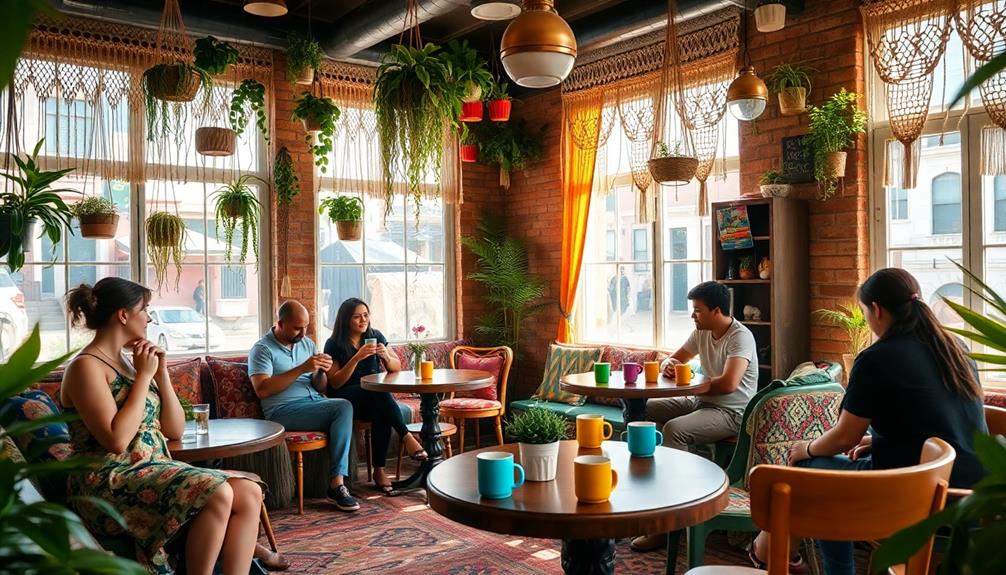
Community-centric boho cafes serve as vibrant cultural hubs, where locals and visitors alike gather to connect and engage.
These spaces are designed to foster social interaction, creating a welcoming atmosphere filled with eclectic decor that reflects the local culture. You'll often find a mix of residents and tourists enjoying the relaxed vibe, making it easy to strike up a conversation or meet new friends.
These cafes often incorporate principles of positive thinking to create an uplifting environment that enhances mental well-being and resilience.
Many of these cafes host workshops, art exhibitions, and live music events, promoting local artists and encouraging community involvement. This not only strengthens social ties but also enriches the local economy.
By sourcing ingredients from nearby farmers and artisans, community-centric boho cafes embrace sustainable practices, ensuring that their unique offerings are both fresh and environmentally friendly.
Whether you're looking for a cozy spot for remote work or a lively place for casual meetups, these cafes provide an ideal backdrop.
Their commitment to community engagement and creativity makes them essential to the social fabric of the area, inviting everyone to be part of something special.
Innovative Menu Options

Exploring a boho cafe often means discovering not just a warm atmosphere but also an innovative menu that excites the palate.
These cafes often prioritize local ingredients, showcasing fresh, organic produce that caters to health-conscious diners. You'll likely find a seasonal menu that changes regularly, ensuring you experience the best flavors each time you visit. Additionally, the influence of global economic trends can impact ingredient availability and pricing, which may reflect in the menu offerings, highlighting the importance of currency fluctuations in international sourcing.
When it comes to beverages, expect artisanal coffee crafted from unique blends, along with creative smoothies and herbal teas infused with exotic flavors. These drinks elevate your overall dining experience, making each sip a delight.
Don't miss out on the creative pastries, either. They're often artfully presented, making them perfect for your Instagram feed.
Many boho cafes also incorporate fusion dishes, merging traditional recipes with modern culinary techniques, so you can enjoy a meal that's both familiar and exciting.
Whether you're looking for a quick bite or a leisurely brunch, the innovative menu options at boho cafes promise to tantalize your taste buds and make your visit memorable.
Artistic Ambiance and Vibes
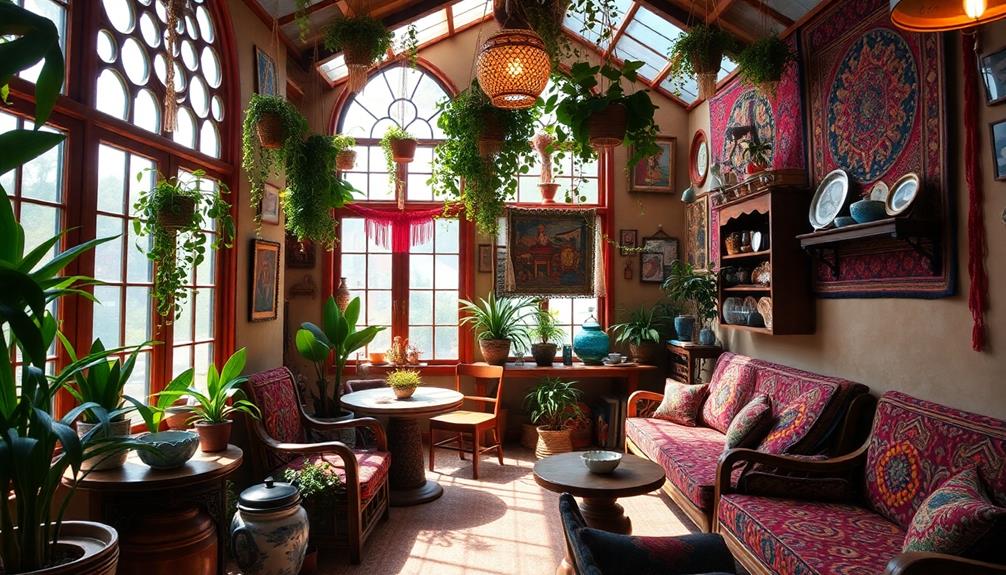
Creating an enchanting experience, boho cafes embody an artistic ambiance that draws you in with their eclectic decor and unique charm. You'll find vintage furniture, colorful textiles, and artistic wall murals that create a cozy atmosphere perfect for relaxing or socializing.
The use of natural elements, like lush plants and greenery, enhances this aesthetic, connecting you to nature and revitalizing your spirit. Many boho cafes incorporate elements of Balinese interior design, such as open spaces and earthy color palettes, to create a serene environment.
As you sip your drink, you'll notice the warm glow of ambient lighting, with soft pendant lights and fairy lights creating an intimate setting. This ambiance invites casual gatherings or quiet reflection, making it an ideal spot to unwind.
Many boho cafes also showcase local art displays, providing a platform for local artists and fostering community engagement. You'll feel the creativity and passion that permeate the space.
When it comes to the menu, you can expect unique food options made with organic ingredients, reflecting the cafe's commitment to quality. Whether you're looking for a light snack or a hearty meal, you'll appreciate the artisanal flair that boho cafes offer, making each visit a delightful experience that celebrates both art and community.
Must-Visit Locations Worldwide
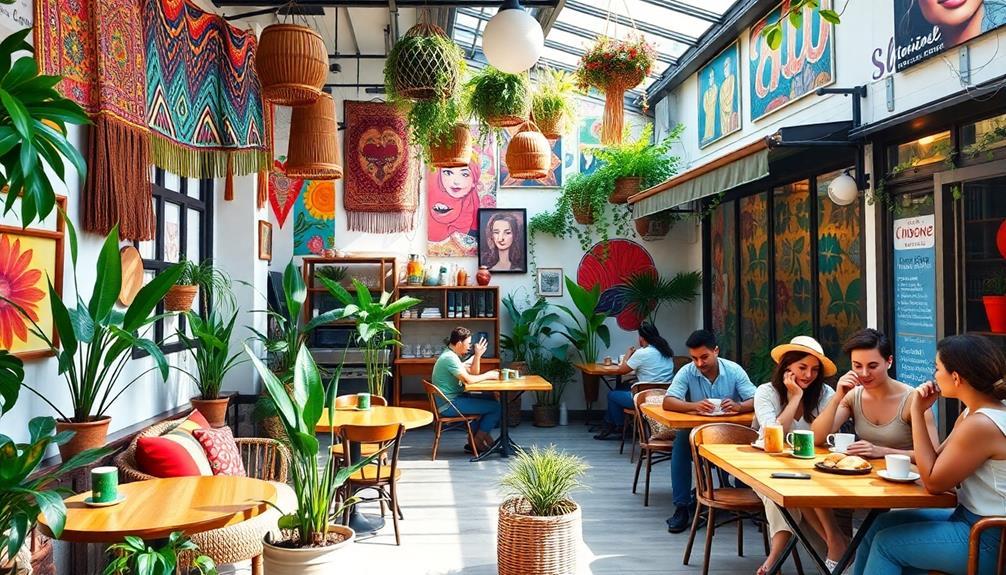
Boho cafes around the globe invite you to experience their unique charm and vibrant atmospheres.
One must-visit location is Kafe Utu in Singapore, a great place adorned with striking artwork and colorful decor that creates a lively setting for social gatherings. The decor often features local influences, much like the intricate designs found in an Indonesian Decor Mask, showcasing rich cultural stories.
In London, Dalloway Terrace stands out with its picturesque floral displays, making it the perfect place for afternoon tea amidst a charming setting.
If you find yourself in Columbus, Ohio, don't miss Fox in the Snow. This cozy coffee shop is famous for its rustic baked goods and inviting ambiance, making it a hidden gem for those looking to relax or work.
Meanwhile, Café de Flore in Paris offers a historic bohemian vibe, frequented by artists and writers, where you can enjoy elegant outdoor seating and classic French pastries.
Frequently Asked Questions
Where Is the Most Beautiful Café in the World?
You might find beauty in many cafés worldwide, but places like the Majestic Café in Porto or Caffè Florian in Venice often steal the spotlight with their stunning decor and rich historical significance.
Which City Has the Best Cafes in the World?
When you consider the best cafes in the world, you'll find Paris's charm, Vienna's elegance, Melbourne's innovation, Tokyo's artistry, and Buenos Aires' culture, each offering unique experiences that captivate coffee lovers and casual visitors alike.
What Is the Most Instagrammed Café in the World?
The most Instagrammed café in the world is Montana del Café in Indonesia. You'll love its stunning views and unique coffee drinks, perfect for capturing memorable moments and sharing your experiences with friends online.
What Are Some Good Café Names?
Imagine sipping coffee in a place called "Wanderlust Brew." You'll adore names like "Serenity Spot," "Mug Life," or "Vegan Delights." Each name invites you to experience its unique ambiance and offerings.
Conclusion
So, next time you're on the hunt for a cozy café, don't bother looking for a place that serves just plain coffee—after all, who wants a normal experience? Instead, embrace the boho charm that wraps you in artistic flair and community spirit. You'll be sipping your artisanal brew surrounded by mismatched furniture and vibrant tapestries, wondering how you ever settled for anything less. Because, let's face it, it's not just coffee; it's an entire lifestyle, right?

